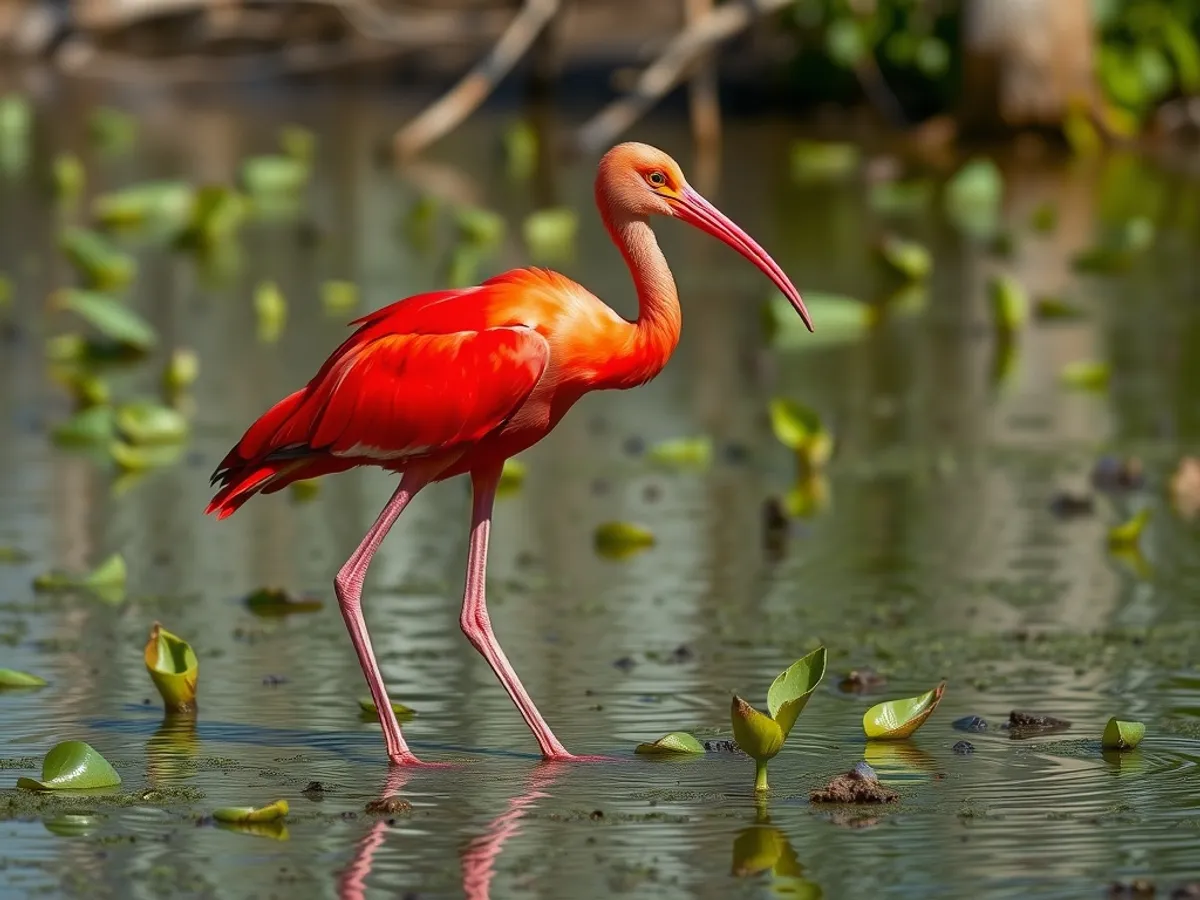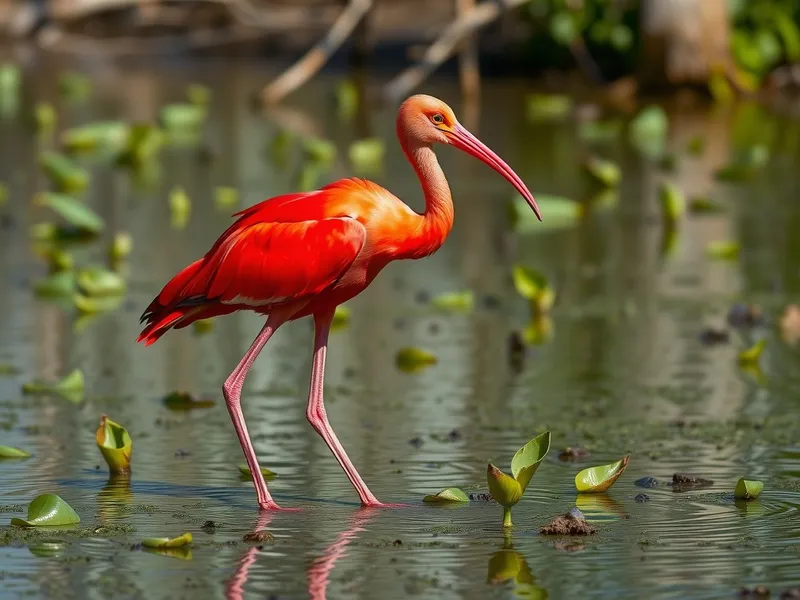
Scarlet Ibis
Eudocimus ruber

Meet the Scarlet Ibis
The Scarlet Ibis is a striking wading bird known for its brilliant red plumage, which develops as the bird matures due to a diet rich in carotenoids. Native to northern South America and the Caribbean, it thrives in wetlands, marshes, and coastal lagoons. Scarlet Ibises are highly social, often nesting and foraging in large colonies, and are easily recognized by their long, curved bills and graceful stature. Their vivid coloration makes them a symbol of tropical beauty and the national bird of Trinidad and Tobago.
Classification
Bird
Habitat
Wetlands and coastal lagoons
Diet
Carnivore
Lifespan
15-20 years
Conservation
Least Concern
Weight
1.4-1.7 kg
📖Fascinating Facts
Brilliant Plumage
The Scarlet Ibis is famous for its radiant red feathers, which come from pigments in the crustaceans it eats.
Colony Nesters
These birds nest in large colonies, sometimes with thousands of individuals, providing protection and social interaction.
Wide Range
Scarlet Ibises are found throughout northern South America and the Caribbean, especially in Trinidad and Tobago and along the Orinoco Delta.
📋Detailed Description
The Scarlet Ibis (Eudocimus ruber) is a medium-sized wading bird, typically measuring 55–63 cm (22–25 in) in length with a wingspan of 52–56 cm (20–22 in) and weighing between 1.4–1.6 kg (3.1–3.5 lbs). Its most distinctive feature is its vivid scarlet plumage, which is present in adults and results from dietary carotenoids, primarily astaxanthin, obtained from crustaceans. Juveniles are born with greyish or white plumage, gradually acquiring their red coloration over the first two years. The Scarlet Ibis has a long, slender, decurved bill adapted for probing mud and shallow water for food. Its legs are long and pinkish-red, aiding in wading through wetlands. The species is highly gregarious, forming large colonies that can number in the thousands, both for roosting and nesting. Their flight is strong and direct, with neck and legs fully extended, and they often migrate in V-shaped formations. The Scarlet Ibis is diurnal, spending daylight hours foraging and socializing, and roosting communally at night in mangroves or tall trees. Vocalizations are generally low-pitched honks or croaks, used for communication within flocks. Their habitats include mudflats, swamps, marshes, estuaries, and mangrove forests, primarily along the northern coast of South America and throughout the Caribbean.
💡 Did you know?
Despite their bold coloring, Scarlet Ibises hatch with gray or brown feathers, only turning scarlet after several years of eating carotenoid-rich foods.
🔬Research & Sources
Wikipedia Summary
The scarlet ibis, sometimes called red ibis, is a species of ibis in the bird family Threskiornithidae. It inhabits tropical South America and part of the Caribbean. In form, it resembles most of the other twenty-seven extant species of ibis, but its remarkably brilliant scarlet coloration makes it unmistakable. It is one of the two national birds of Trinidad and Tobago, and its Tupi–Guarani name, guará, is part of the name of several municipalities along the coast of Brazil.
Last Modified: 3/6/2025
🎭Behavior & Social Structure
Scarlet Ibises are highly social birds, rarely seen alone outside the breeding season. They forage in flocks, often alongside other wading species, using their sensitive, curved bills to probe for crustaceans, insects, small fish, and mollusks in soft mud or shallow water. Feeding is most active during early morning and late afternoon. Social hierarchies are observed within colonies, with dominant individuals gaining better access to food and nesting sites. They engage in mutual preening and synchronized group movements, which help reduce predation risk. During flight, they maintain tight formations, which may aid in energy conservation and navigation. Roosting occurs in large groups, providing safety in numbers. Aggressive interactions are generally limited to competition for nesting sites or mates during the breeding season.
👶Reproduction & Life Cycle
Scarlet Ibises breed seasonally, with timing varying by region but often coinciding with the rainy season (typically April to August in Trinidad and northern South America). They are monogamous during the breeding season, forming pairs that cooperate in nest building and chick rearing. Nests are constructed from sticks and vegetation, usually in mangrove trees or dense shrubs above water to deter predators. Females lay 2–4 pale blue-green eggs, which are incubated by both parents for about 19–23 days. Hatchlings are altricial, covered in sparse down and dependent on parental care. Both parents feed the chicks by regurgitation. Fledging occurs at around 35–42 days, but juveniles may remain with parents for several weeks post-fledging. High nest density and colonial nesting provide some protection against predation, though eggs and chicks are vulnerable to raptors, snakes, and mammals.
🛡️Adaptations & Survival
The Scarlet Ibis exhibits several key adaptations for its wetland habitat. Its long, decurved bill is highly sensitive and specialized for tactile foraging in mud and shallow water, allowing it to detect and extract hidden prey. The vivid red coloration, derived from dietary carotenoids, may serve as a signal of individual health and fitness, playing a role in mate selection. Their long legs and partially webbed feet facilitate efficient wading and stability on soft substrates. Social behaviors, such as colonial nesting and synchronized flock movements, enhance predator avoidance and foraging efficiency. Physiologically, they are tolerant of saline environments and can exploit both freshwater and brackish habitats. Their migratory and dispersal abilities allow them to exploit seasonally variable resources and avoid local environmental stressors.
📚Research Sources
🎨Cultural Significance
The Scarlet Ibis holds profound cultural importance, especially in Trinidad and Tobago, where it is one of the two national birds and features prominently on the country’s coat of arms and currency. Its striking appearance has inspired local folklore, art, and literature, symbolizing beauty, vitality, and the unique biodiversity of the region. In indigenous Tupi–Guarani culture, the bird is known as 'guará' and is referenced in place names along the Brazilian coast. The Scarlet Ibis is also a flagship species for wetland conservation in South America and the Caribbean, drawing ecotourism and fostering environmental awareness.
🔬Recent Research & Discoveries
Recent research has focused on the role of carotenoids in plumage coloration, revealing that the intensity of red coloration is a reliable indicator of individual health and reproductive fitness. Genetic studies have examined hybridization between Scarlet Ibis and the closely related White Ibis (Eudocimus albus), particularly in areas of range overlap, with evidence of gene flow and intermediate plumage in hybrids. Ongoing ecological studies monitor population trends, migratory movements, and the impacts of habitat alteration. Conservation research in Trinidad has highlighted the importance of protected areas such as the Caroni Swamp for sustaining breeding colonies. Studies on foraging ecology have detailed the ibis’s role in controlling aquatic invertebrate populations, contributing to wetland ecosystem health.
🎥Wildlife Videos

CH5 Nature Documentary - Land of the Scarlet Ibis (1999)
"Land of the Scarlet Ibis" is an extraordinary nature documentary that takes you on a journey to the heart of South America, where ...
EarthBound 104

"Animal Edens Land of the Scarlet Ibis"
Join us on a breathtaking journey to the remote wetlands of Trinidad and Tobago, where one of the world's most stunning birds, ...
Tranquilites Ebb and Flow

🌺 Discover the Stunning Scarlet Ibis: Top 15 Fascinating Facts! 🦜 | TK A-Z
scarlet ibis, bird watching, wildlife documentary, nature video, exotic birds, tropical birds, bird migration, bird behavior, bird habitat, ...
TK A-Z

Trinidad & the Scarlet Ibis | Wild Caribbean | BBC Studios
... this beautiful footage of the Trinidad native bird, the Scarlet Ibis. Clip taken from BBC wildlife documentary 'Wild Caribbean'.
BBC Studios

Scarlet Ibis - A Documentary
Naylan Dwarika

The Scarlet Ibis: Nature’s Fiery Masterpiece!
The Scarlet Ibis isn't just a bird—it's a living flame soaring through tropical skies! In this video, we uncover fascinating facts about ...
Beyond the Senses
🌍Habitat Information
The Scarlet Ibis typically inhabits Wetlands and coastal lagoons environments. Scarlet Ibiss have adapted to their environments with specialized features and behaviors.
Primary Habitat:
Wetlands and coastal lagoons
More detailed habitat information will be available soon.
🛡️Conservation Status
The Scarlet Ibis is currently classified as Least Concern. Conservation efforts are crucial for preserving this species for future generations.
Common Threats:
- 🏠Habitat loss and fragmentation
- 🌡️Climate change impacts
- 🎯Hunting and poaching
- 🏭Human-wildlife conflict
⚠️Threats & Conservation Challenges
While the Scarlet Ibis is currently listed as Least Concern by the IUCN, it faces several localized threats. Habitat loss and degradation, especially the destruction of mangroves and wetlands for agriculture, urban development, and aquaculture, pose significant risks. Pollution, particularly from pesticides and heavy metals, can affect food availability and reproductive success. Illegal hunting for feathers and eggs, though reduced, still occurs in some regions. Human disturbance at nesting colonies can lead to nest abandonment and increased predation. Climate change and associated sea-level rise threaten low-lying coastal habitats. Despite these challenges, the species remains widespread and locally abundant, though some populations are in decline, emphasizing the need for continued habitat protection and monitoring.
🔬Scientific Classification
Scientific Name
Eudocimus ruber
Classification Hierarchy
🔍 About Taxonomic Classification
Taxonomic classification is a hierarchical system used by scientists to classify and organize living organisms based on shared characteristics and evolutionary relationships.
The system moves from broad categories (Kingdom) to increasingly specific ones, with each animal's scientific name typically consisting of its Genus and species.
📝Community Notes
Share your observations and insights about the Scarlet Ibis with our community of wildlife enthusiasts.
Join Our Community
Sign in to share your observations and connect with fellow wildlife enthusiasts.
Sign In to ContributeNo community notes yet
Be the first to share your observations about the Scarlet Ibis!
Explore Scarlet Ibis
Select a tab above to learn more about this amazing animal.
📸Photo Gallery
No photos available for this animal yet.
🌟Discover More Wildlife
Continue your journey of discovery with more fascinating animals from our database
